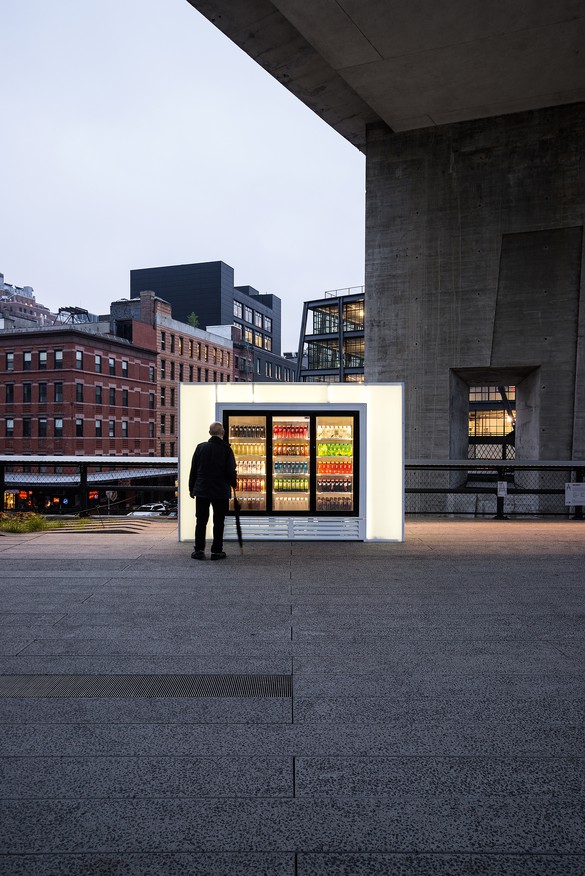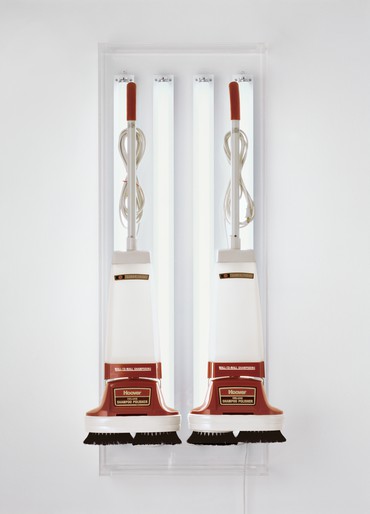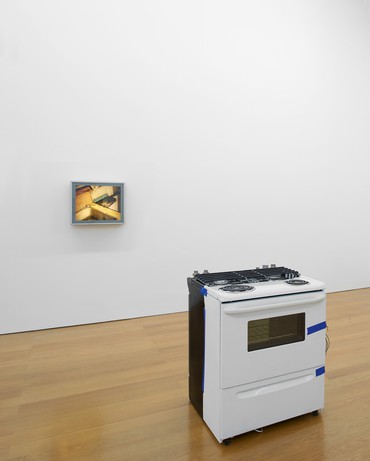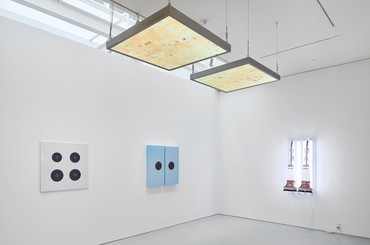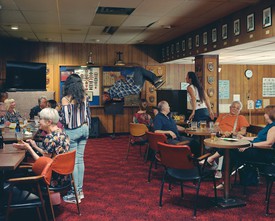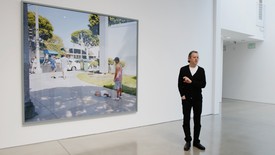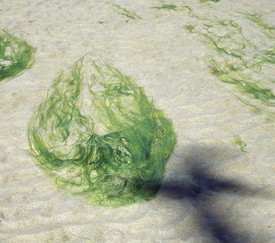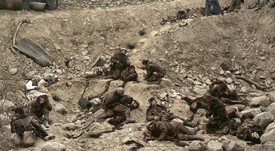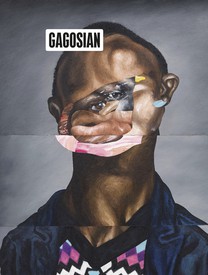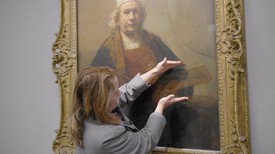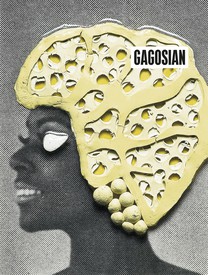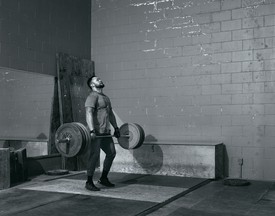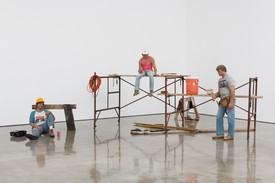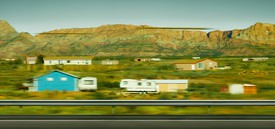
Wyatt Allgeier is a writer and an editor for Gagosian Quarterly. He lives and works in New York City.
The series of theses that make up Guy Debord’s seminal book La société du spectacle (The Society of the Spectacle), published in 1967, update the economic analysis performed by Karl Marx exactly one hundred years prior in Das Kapital. Debord’s polemic carries Marxian terms—alienation, commodity, surplus value, labor—onto new ground, updating them for an era of media interfaces, advertising, and calculated marketing; he was playing catch-up with techniques of capitalism that were becoming ever more sophisticated and totalizing. This was the 1960s, the decade of Madison Avenue admen. By the beginning of that decade, 90 percent of American households had a television beaming commercials and narratives of well-functioning consumer-subjects into their inhabitants’ brains. Andy Warhol would soon be depicting this advance logic of spectacular capital with his repetitions of Campbell’s soup cans and Brillo boxes, artworks as much a result of the circumstances from which they were born as prophetic of an intensification just around the corner. For if there is one tenet that both Marx and Debord held as true, it was that capital doesn’t slow down in its quest for ever greater reach, ever greater profits, ever more control of societal ecologies. The health of the capitalist system depends on expansion.
What La société du spectacle succeeds in is demystifying the functions of power undergirding this ceaseless expansion—an expansion into the creation of semiological meaning, into the deification and abstraction of commodity forms, and into our minds. When Debord writes of the commodity in the world of the spectacle, he is not writing of a product-simple; the commodity is not the lipstick in your hands at the glass counter at Macy’s, but the idea of lipstick that made you pick up the case in the first place. The commodity is the apex of a mountain of marketing, an apparatus of meaning-making that successively defines products within matrices of aspiration, morality, and success. As Debord writes in his sixty-seventh thesis,
The satisfaction that the commodity in its abundance can no longer supply by virtue of its use value is now sought in an acknowledgment of its value qua commodity. A use of the commodity arises that is sufficient unto itself; what this means for the consumer is an outpouring of religious zeal in honor of the commodity’s sovereign freedom. Waves of enthusiasm for particular products, fueled and boosted by the communications media, are propagated with lightning speed. A film sparks a fashion craze, or a magazine launches a chain of clubs that in turn spins off a line of products. The sheer fad item perfectly expresses the fact that, as the mass of commodities become more and more absurd, absurdity becomes a commodity in its own right. . . . Following in the footsteps of the old religious fetishism, with its transported convulsionaries and miraculous cures, the fetishism of the commodity also achieves its moment of acute fervor. The only use still in evidence here, meanwhile, is the basic use of submission.1
As consumers we submit to the commodity, and our submission allows capitalism to continue its growth. Every item consumed is a service to the machinations that are. Consumption may be our most important labor. Capital cannot lie idle; it is ruled by what Marx called “laws of motion,” economic propulsions toward profit and increased production that we are trained to keep oiled with our labor and our desire for more commodities. Here the “new” takes on a singular role, made clear through the language of advertising: the “latest,” the “innovative,” the “groundbreaking,” the “trailblazing,” and, a particular favorite of late, the “revolutionary.” That a day doesn’t go by in 2019 without some new “disruptor”—a word we’re meant to consume as meaning exciting, positive, possibly erotic—entering the economic arena speaks to the ingenuity of the spectacle’s use of language: in the logic of capitalism, “new” must mean “good,” even when the vocabulary clothing it is explicitly hostile.
That Koons makes us ask ourselves, “Is a vacuum cleaner or a basketball as worthy of adulation as a Bernini sculpture?” is a thought-inducing event. Saying yes or no to that question—it doesn’t matter which—results in a concatenation of further questions, skillfully disrupting the easy flow of unchecked growth.
That artworks would have a unique stake in these semiotic systems is hardly surprising, for art, with rare exceptions, lives entirely under the optical regime. It is traditionally a domain of creating meaning in physical form, carried on in an attempt to communicate with the world through the eye. Debord’s eighteenth thesis states, “Since the spectacle’s job is to cause a world that is no longer directly perceptible to be seen . . . it is inevitable that it should elevate the human sense of sight to the special place once occupied by touch; the most abstract of the senses, and the most easily deceived, sight is naturally the most readily adaptable to present-day society’s generalized abstraction.”2 So it happens that art lands smackdab in the complexity of capitalism’s strategies of mystification.
Twenty years after Debord made his case against the spectacle, Jeff Koons presented an exhibition at the Daniel Weinberg Gallery, Los Angeles, entitled The New: Encased Works. The exhibition comprised a series of works, collectively known as The New, that consists of various models of floor cleaners. These vacuums, polishers, and carpet cleaners are encased like marvelous artifacts in plexiglass boxes and lit by rows of fluorescent lights, the better for you to see them in all their glorious, shiny newness. Koons has spoken of these and various later works in tones of religious adoration. The vacuums in particular, which work to make one’s environment hygienic, are indeed idols for the spectacular world we live in, where our faces and homes are always in need of some new item to clean and beautify them. Recall Debord’s understanding of the commodity as “following in the footsteps of the old religious fetishism, with its transported convulsionaries and miraculous cures.” For Koons, wonderfully, this understanding is not necessarily a critique—all we know as viewers is that in the presence of these exalted products we feel a twinge of awe. That the Hoovers are now outdated in both function and aesthetic couldn’t be more perfectly to the point: here again, the relentless thrust forward of capitalism.
Other artists of the 1980s grappled with commodity fetishization in other ways; the bending of marketing’s techniques to different ends was a powerful current in the art of the time. Jeff Wall presented his photographs as backlit transparencies in lightboxes, the same devices used to catch our attention in groceries and department stores. Projected light, such a powerful tool in selling products (perhaps most famously in Times Square), became a technique that Wall recontextualized to present his simultaneously cerebral and beguiling photographs. Jenny Holzer co-opted the typography of advertising to make sure that her critical aphorisms were read by viewers conditioned by billboards, magazine ads, and quick television spots. Cady Noland utilized mass-produced commodities, items that, by the time she engaged with them, were relegated to trash: Budweiser cans, cigarettes, tabloids. These now useless commodities were the raw materials for Noland’s potent critiques of American violence, greed, and rotten masculinity. Rosemarie Trockel’s 1980s work opened up questions of gender and labor by presenting belittled forms of craft—knitting and cooking—in the forms and venues of high culture. The forceful Untitled (1987), for example, repurposes a stove’s electric burners as formal, minimal sculptural objects. Trockel similarly used industrialized knitting machines to adapt the crafts of garment-making, with their gendered connotations, to graphic “knitting pictures” as exquisite as the much-admired creations of male minimalists from Piet Mondrian to Frank Stella. Richard Prince, beginning in the late 1970s, was rephotographing advertisements, a gesture that twisted the task of commodity elevation into an object playing itself. His Untitled (jewels, watch and pocketbook) (1979) no longer propels the selling of those jewels, watches, and pocketbooks; it is no longer a set of abstracted signs of luxury, meant to be understood subconsciously. What possibilities for freedom can be found through commercial strategies when there is no commodity being sold? What discoveries can the eye uncover when it is momentarily loosed from the demands of self-branding and mass consumption?
If only it were so simple. That art is sold, that it is marketed as an abstract commodity in itself, makes us question the efficacy of its critiques. In the best-case scenario it can and should be said that an artwork has the power to unveil and articulate concepts, systems, and techniques of power. That Holzer’s punchy declaratives can force viewers to reanalyze the messages they are constantly presented with better equips them for a more nuanced and critical experience of being-in-the-world. That Koons makes us ask ourselves, “Is a vacuum cleaner or a basketball as worthy of adulation as a Bernini sculpture?” is a thought-inducing event. Saying yes or no to that question—it doesn’t matter which—results in a concatenation of further questions, skillfully disrupting the easy flow of unchecked growth.
Here, in 2019, the spectacle, naturally, is even more unwieldy and present than in the 1980s. The television was child’s play compared to the all-in-one interface of the Internet, a virtual, abstracted arena where consumption is the rule. A “place” where you can order a shirt that is pure image until it arrives at your doorstep: you’ve consumed based solely on the idea of the shirt, free of its objecthood, its sensations, its being-such. Debord would have been floored. And as we hurtle along, a whole society pushing the limits of meaning and being, economic parity continues to crumble exponentially. As one large labor force devotes itself to amassing Instagram likes—pure absurdity as social capital—another dons yellow vests in the streets of Paris because it can’t afford a dignified life. Meanwhile, metropolitan subjects widely resort to devices that make the labor of being-desirable, as worker, sex object, and consumer, more efficient (the gym: $300-a-month memberships; the juice cleanse: $15 for eight ounces of vegetables) as they work toward producing the ultimate commodity, their selves. And meanwhile again, automation results in the layoff of factory workers in industries around the world. As new technologies—necessary by-products of economic vitality under capitalism—continue to accrue, we can be certain that more jobs will be outmoded, rendered moot by a robot, an algorithm, or simply by the fact that not enough consumers want the product anymore.
Twenty-first-century artists working in this accelerated, precarious, chimerical reality, where traditional lines of labor, commodity, and class-consciousness constantly reformulate, are under duress to come up with new questions in ways both similar to and radically different from their predecessors in the 1980s. Josh Kline’s Skittles (2014) approaches critique on a formal level in a way reminiscent of many of the Pictures Generation’s experiments in appropriation and subversion. The sculpture, exhibited in the 2014–15 exhibition Archeo on the New York High Line, comprises a beverage case containing various “juices”—aesthetically akin in their packaging and well-lit presentation to Juice Press drinks, which promise positive vibes, revitalization, unfailing health, and other qualities essential to our New Age lives as well-balanced consumers—but containing ingredients given on the medium list as, e.g., Mr. Clean, money order, medical scrubs, french fries, toilet paper, phone card, latex gloves, pennies. This concoction is named Minimum Wage. As Andrea K. Scott wrote in the New Yorker, “Think of Skittles as Duchamp’s Bottle Rack, updated for the age of aspirational marketing, when even a smoothie can be spun as a status symbol. The case is locked and the bottles are beyond reach, but you can press your nose to the glass.”3 If Marcel Duchamp aimed for a philosophical probing of the definition of art, I’d say Kline’s Skittles undergoes an experiment more akin to Koons’s vacuums and Wall’s lightboxes: the viewer is confronted with a familiar-looking commodity, and in a quotidian presentation, that through considered alteration nevertheless asks viewers to reconsider their relationship to the item outside of the buy-sell continuum.
Twenty-first-century artists working in this accelerated, precarious, chimerical reality, where traditional lines of labor, commodity, and class-consciousness constantly reformulate, are under duress to come up with new questions in ways both similar to and radically different from their predecessors in the 1980s.
Kline’s work has since evolved. “Before 2014,” he remarked in a recent interview, “I was making work that was about an extreme present—distilling out aspects of our time that are different from the past and different, perhaps, from the future. I was trying to talk about the future through the present, talking about things like posthuman or nonhuman or transhuman states that are coming into being via certain kinds of precarious labor conditions.”4 Since then, Kline has begun his Unemployment and Civil War series, which attempt the visionary—as in seeing-into-the-future—work of sketching possible results of the current state of wealth inequality and technological obsolescence. A work such as Sighs of the Times (2017) presents the viewer with gray piles of discarded objects—once shiny and new, like a Hoover floor polisher, now inert, broken, and possible ammunition in a riot. Kline’s work in the Civil War series demands a reckoning with the unchecked growth and abstraction of a now virtual capitalism, and in so doing carves a niche in which art might powerfully serve a society grasping for alternatives to a regime indifferent—by definition and design—to inequality and undignified human life.
Anicka Yi is another artist offering flight routes or escape hatches from the prevailing logic of branding, commerce, self-improvement, and mediated life. Her multisensory experiments utilize senses of smell and touch—both anathema to the optical primacy of the Debordian spectacle—to propose biological, microbial, and ephemeral ways of being-in-the-world. “I’m coming from the perspective of the decentered human, of challenging human exceptionalism,” Yi explains, “which is why I work with bacteria, why I work with organic matter.”5 In using the unseen as a way to challenge humanity’s prevailing sense of its uniqueness, Yi diversifies our understanding of ecosystems, forcing a line of questioning that leads to a realization about the permeability of the self. The fragility of the individual punctures holes in capitalism’s techniques of making its commodities seem essential add-ons if we are to be “whole.”
Faced with the totality of a necessarily dispassionate and ruthless economy, artists have sought to disarm, recontextualize, slow down, satirize, praise, and foretell the always expanding progress of capitalism. These responses show clearly that the system allows no “outside”; the only interactions possible take place within this intricate complex of mediated, global, economic existence. Faced with the unremitting technological advancements of the twenty-first century, both Yi and Kline point toward potentials for the future—which, granted, is still not so rosy. Thinking through the dissolution of human-centered civilization under the unchecked proliferation of capital, Yi states,
At first I was worried about that dismantling, but this is also part of evolution. The rise of automation, for example—to me it’s part of a larger system; it’s not the end of evolution, because you can’t destroy nature; nature always wins. However, what’s interesting is that we’re now open to the idea that consciousness is decoupled from intelligence. Consciousness has been at the apex in terms of rights. Who has rights? Those who have consciousness. And yet with artificial intelligence we’re increasingly outsourcing our viability; this intelligence decoupled from consciousness is actually probably going to usurp us all.6
Could there be a more perfect ending? For what is the ultimate dream of the spectacle other than a world in which tricky, complicated humans are eliminated from the equation altogether (we’re so inefficient), and in which commodities are able to buy commodities. An Amazon Alexa will order an Amazon Alexa to handle the necessary work of ordering more Amazon Alexas. The only remaining question: What happens to us?
1Guy Debord, The Society of the Spectacle, trans. Donald Nicholson-Smith (New York: Zone Books, 2012), pp. 43–44.
2Ibid., p. 17.
3Andrea K. Scott, “Parklife,” The New Yorker, June 9, 2014. Available online at www.newyorker.com/magazine/2014/06/09/parklife (accessed March 18, 2019).
3Josh Kline, in an interview with Sam Orlofsky, 2019, in “Fiction or Future,” Gagosian Quarterly, January 24, 2019. Available online at https://gagosian.com/quarterly/2019/01/24/interview-josh-kline-anicka-yi/ (accessed March 18, 2019).
5Anicka Yi, in an interview with Orlofsky, 2019, in ibid.
6Ibid.
Laws of Motion: Josh Kline, Jeff Koons, Cady Noland, Rosemarie Trockel, Jeff Wall, Anicka Yi, Gagosian, Hong Kong, November 20–December 21, 2018; Gagosian, San Francisco, January 14–March 9, 2019
